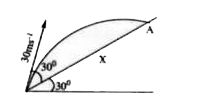An object Is vertically projected with an initial velocity of 20ms−1.Calculate the distance travelled by the object in 3 seconds.(g=10ms−2)
To solve the problem of calculating the distance traveled by an object projected vertically with an initial velocity of 20m/s in 3 seconds, we can use the following kinematic equation:
s=ut−12gt2
Where:
- s = displacement (distance traveled)
- u = initial velocity
- t = time
- g = acceleration due to gravity (which is taken as 10m/s2 and is negative when considering upward motion)
1. Identify the given values:
- Initial velocity, u=20m/s
- Time, t=3s
- Acceleration due to gravity, g=10m/s2
2. Substitute the values into the equation:
s=ut−12gt2
s=(20m/s)(3s)−12(10m/s2)(3s)2
3. Calculate the first term:
ut=20×3=60m
4. Calculate the second term:
12gt2=12(10)(32)=12(10)(9)=45m
5. Combine the results to find the displacement:
s=60m−45m=15m
Final Answer:
The distance traveled by the object in 3 seconds is 15m.
---
- s = displacement (distance traveled)
- u = initial velocity
- t = time
- g = acceleration due to gravity (which is taken as 10m/s2 and is negative when considering upward motion)
- Initial velocity, u=20m/s
- Time, t=3s
- Acceleration due to gravity, g=10m/s2
s=ut−12gt2
s=(20m/s)(3s)−12(10m/s2)(3s)2
ut=20×3=60m
12gt2=12(10)(32)=12(10)(9)=45m
s=60m−45m=15m
The distance traveled by the object in 3 seconds is 15m.
Topper's Solved these Questions
- MOTION IN A STRAIGHT LINE BOOK - AAKASH SERIESCHAPTER - MOTION IN A STRAIGHT LINE EXERCISE - Numerical exercise(LEVEL-2)
29 Videos
- MOTION IN A STRAIGHT LINE BOOK - AAKASH SERIESCHAPTER - MOTION IN A STRAIGHT LINE EXERCISE - Question for descriptiv Answers
7 Videos
- MOTION IN A STRAIGHT LINE BOOK - AAKASH SERIESCHAPTER - MOTION IN A STRAIGHT LINE EXERCISE - problems
47 Videos
- MOTION IN A PLANEBOOK - AAKASH SERIESCHAPTER - MOTION IN A PLANEEXERCISE - QUESTION FOR DESCRIPTIVE ANSWER
7 Videos
- MOVING CHARGES AND MAGNETISMBOOK - AAKASH SERIESCHAPTER - MOVING CHARGES AND MAGNETISMEXERCISE - EXERCISE-III
49 Videos
Similar Questions
A body is projected with a velocity 60ms−1 vertically upwards the distance travelled in last second of its motion is [g=10ms−1]
View SolutionA body starts with an initial velocity of 10 ms and acceleration 5 ms. Find the distance covered by it in 5 s.
View SolutionA body starting from rest has an acceleration of 4ms−2 . Calculate distance travelled by it in 5th second.
View SolutionA body is projected with a velocity 50ms−1. Distance travelled in 6th second is [g=10ms−2]
View SolutionA particle is projected vertically upwards with a velocity of 20m/sec. Find the time at which distance travelled is twice the displacement
View SolutionAn object in projected up the inclined at the angle shown in the figure with an initial velocity of 30ms−1. The distance x up the incline at which the object lands is

View SolutionA stone is dropped from the top of a tower and one second later, a second stone is thrown vertically downward with a velocity 20ms−1. The second stone will overtake the first after travelling a distance of (g=10ms−2)
View SolutionAn object is projected with a velocity of 30ms−1 at an angle of 60∘ with the horizontal. Determine the horizontal range covered by the object.
View SolutionInitially a body is at rest. If its acceleration is 5ms−2 then the distance travelled in the 18th second is :-
View SolutionA body is thrown up with a velocity 29.23ms−1 distance travelled in last second of upward motion is
View Solution
